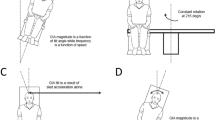Summary
We used the magnetic search coil technique to record horizontal (yaw) and vertical (pitch) head rotations of 20 normal subjects during (1) walking in place, (2) running in place, (3) vigorous, voluntary, horizontal head rotation and (4) vigorous, voluntary, vertical head rotation. During walking or running, the predominant frequency of pitch rotations was at least twice that of yaw rotations. During running, the median, predominant pitch frequency from all subjects was 3.2 Hz, but significant harmonics were present up to 15-20 Hz in several subjects. Group median maximal head velocity during walking or running did not exceed 90 degrees/ second. During vigorous, voluntary head rotations median frequency for yaw and pitch was similar and did not exceed 2.6 Hz. However, group median maximal head velocity during vigorous voluntary yaw rotation was 780 degrees/second. Thus, (1) during locomotion, the head is stabilized in space incompletely but adequately so that the vestibulo-ocular reflex (VOR) is not saturated, (2) during vigorous, voluntary head rotations, the maximum head velocity exceeds the range where the VOR can stabilize gaze, (3) the frequencies of head rotations that occur during locomotion greatly exceed frequencies conventionally used in the laboratory for testing the VOR.
Similar content being viewed by others
References
Antonsson EK, Mann RW (1985) The frequency content of gait. Biomech 18: 39–47
Baloh RW, Honmbia V, Yee RD, Hess K (1984) Changes in human vestibulo-ocular reflex after loss of peripheral sensitivity. Ann Neurol 16: 222–228
Cappozzo A, Figura F, Marchetti M (1976) The interplay of muscular and external forces in human ambulation. J Biomech 9: 35–43
Cavagna GA, Franzetti P (1986) The determinants of the step frequency in walking in humans. J Physiol (Lond) 373: 235–242
Collewijn H (1977) Eye- and head movements in freely moving rabbits. J Physiol (Lond) 266: 471–498
Ferman L, Collewijn H, Jansen TC, Van den Berg AV (1987) Human gaze stability in the horizontal, vertical and torsional direction during voluntary head movements, evaluated with a three-dimensional scleral induction coil technique. Vision Res 27: 811–828
Gauthier GM, Piron J, Roll J, Marchetti E, Martin B (1984) Highfrequency vestibulo-ocular reflex activation through forced head rotation in man. Aviat Space Environ Med 55: 1–7
Gresty MA, Hess K, Leech J (1977) Disorders of the vestibuloocular reflex producing oscillopsia and mechanisms compensating for loss of labyrinthine function. Brain 100: 693–716
Grossman GE, Abel LA, Thurston SE, Dell'Osso LF, Ruff RL, Leigh RJ (1986) Frequency and velocity ranges of natural head rotations. Soc Neurosci Abstr 12 (Part 1): 251
Guitton D, Kearney RE, Wereley N, Peterson BW (1986) Visual, vestibular and voluntary contributions to human head stabilization. Exp Brain Res 64: 59–69
Hydén D, Istl Y, Schwarz DWF (1982) Human visuo-vestibular interaction as a basis for quantitative clinical diagnostics. Acta Otolaryngol 94: 53–60
Light LH, McLellan GE, Klenerman L (1980) Skeletal transients on heel strike in normal walking with different footwear. J Biomech 13: 477–480
Paige GD (1983) Vestibuloocular reflex and its interaction with visual following mechanisms in the squirrel monkey. 1. Response characteristics in normal animals. J Neurophysiol 49: 134–151
Paige GD (1986) Vestibulo-ocular reflex (VOR) during vertical linear motion. Soc Neurosci Abstr 12 (Part 1): 253
Probst R, Brandt T, Degner D (1986) Object-motion detection affected by concurrent self-motion perception: psychophysics of a new phenomenon. Behav Brain Res 22: 1–11
Pulaski PD, Zee DS, Robinson DA (1981) The behavior of the vestibulo-ocular reflex at high velocities of head rotation. Brain Res 222: 159–165
Robinson DA (1963) A method of measuring eye movement using a scleral search coil in a magnetic field. IEEE Trans Bio-Med Electron BME-10: 137–145
Simon SR, Paul IL, Mansour J, Munro M, Abernethy PJ, Radin EL (1981) Peak dynamic force in human gait. J Biomech 14: 817–822
Tomlinson RD, Saunders GE, Schwarz DW (1980) Analysis of human vestibulo-ocular reflex during active head movements. Acta Otolaryngol 90: 184–190
Viire E, Tweed D, Milner K, Vilis T (1986) A reexamination of the gain of the vestibuloocular reflex. J Neurophysiol 56: 439–450
Wilson VJ, Melvill Jones G (1979) Mammalian vestibular physiology. Plenum, New York
Wist ER, Brandt T, Krafczyk S (1983) Oscillopsia and retinal slip: evidence supporting a clinical test. Brain 106: 153–168
Author information
Authors and Affiliations
Rights and permissions
About this article
Cite this article
Grossman, G.E., Leigh, R.J., Abel, L.A. et al. Frequency and velocity of rotational head perturbations during locomotion. Exp Brain Res 70, 470–476 (1988). https://doi.org/10.1007/BF00247595
Received:
Accepted:
Issue Date:
DOI: https://doi.org/10.1007/BF00247595




